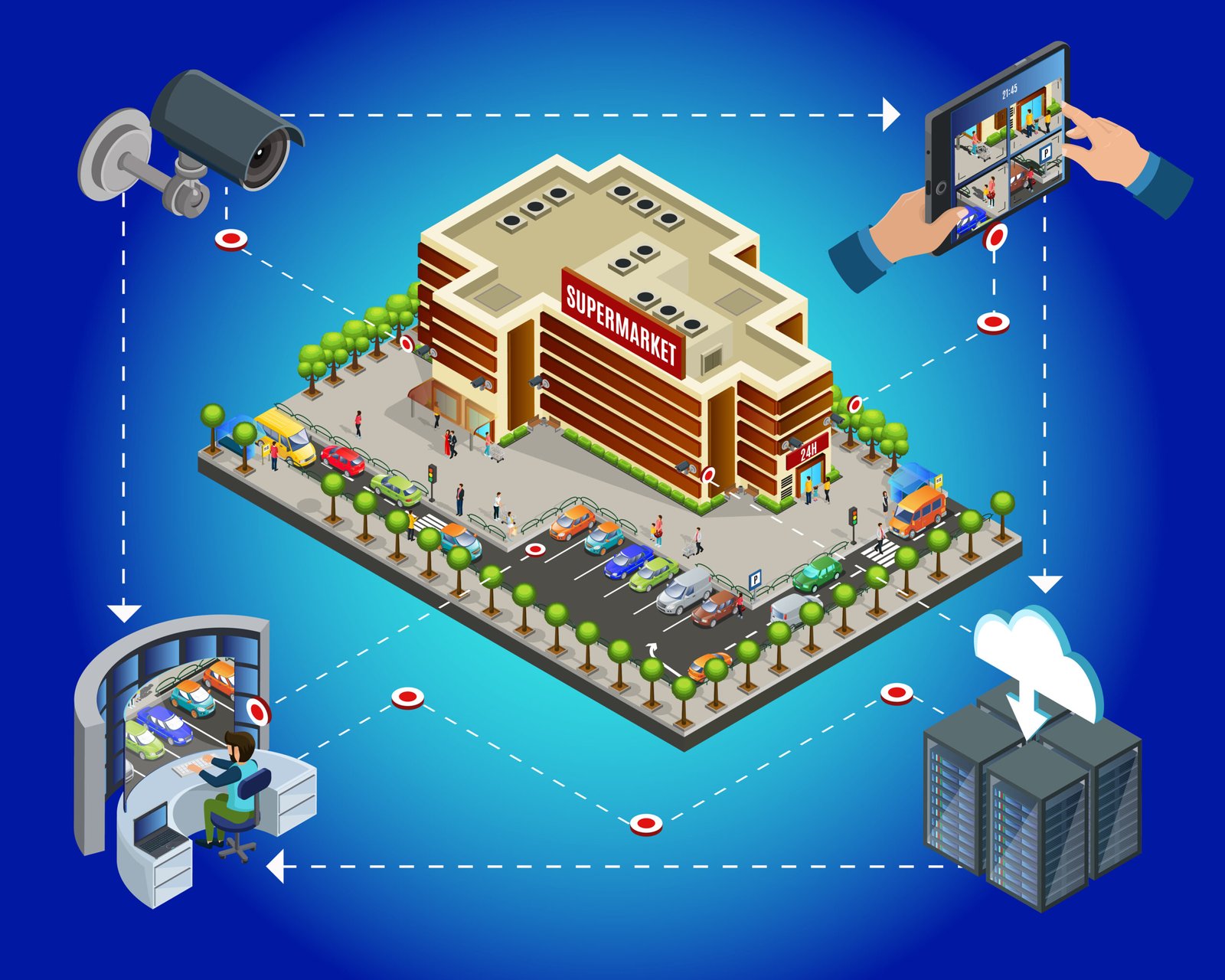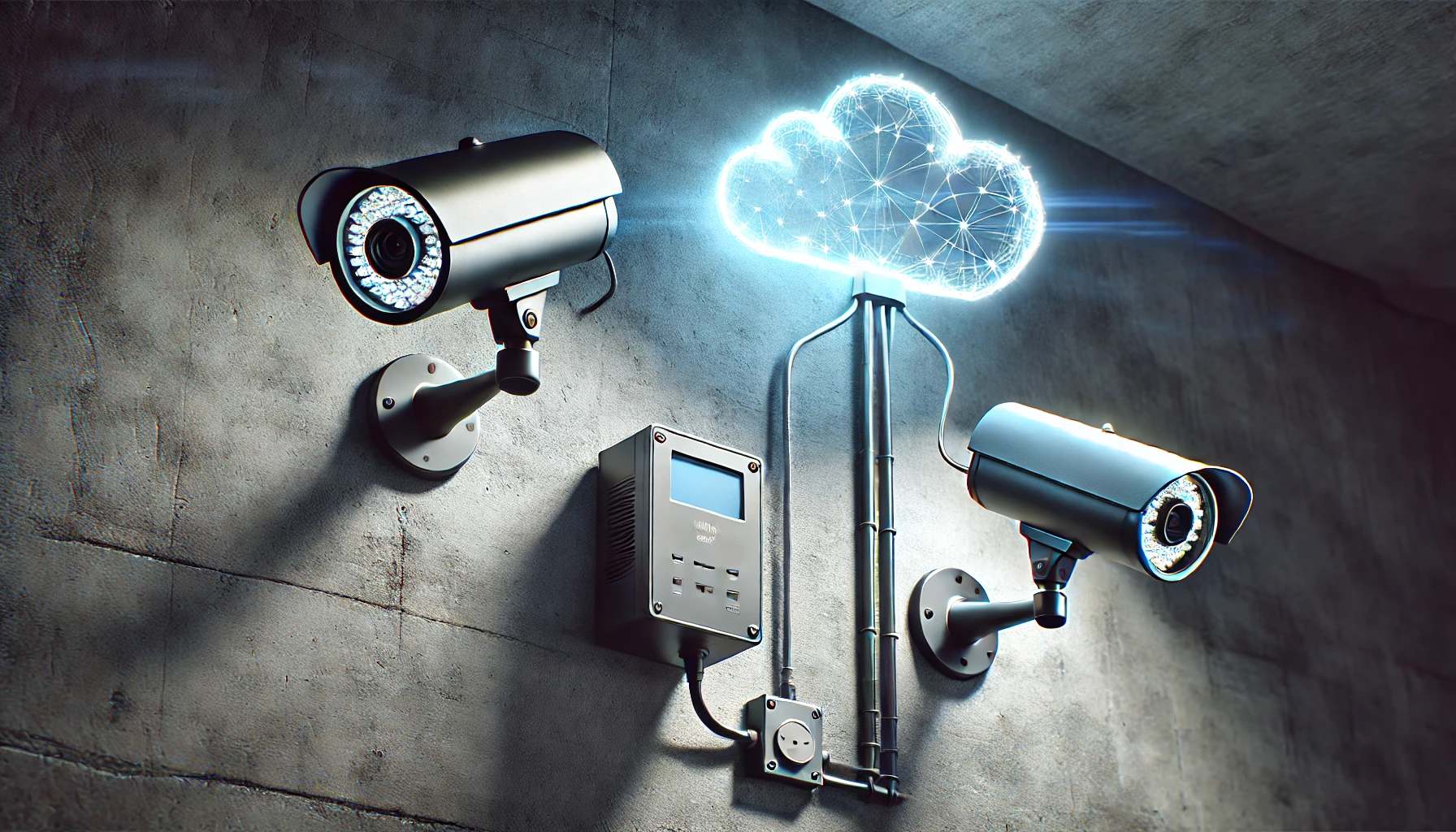The world of security and surveillance is not what we knew a decade ago. Perhaps we were to trust our assets to one or two men to guard them over night, however this concept over complicated the entire process. From human error to limitations of vision to massive scaling of properties rose the need of a better solution to the security and surveillance of our assets, weather it was out stocks , company grounds or even if it was our own home. The creation of cameras revolutionized the industry of security, protection and surveillance but still, the question remained: was I enough for us to trust everything on it?
Nowadays with the birth of artificial intelligence once more we have the opportunity to upscale our game that is protection, security and surveillance tasks. Thus we are to embark on a journey to learn about Cloud-Based Video Surveillance.
What is Cloud-Based Video Surveillance?

Cloud based video surveillance is a system in which captured videos are not stored physically but are stored on the internet. Not only that the server that stores our data also has the capability to analyze it with great precision and features. Noticing even the slightest irregularities and acting upon them. No more storing data on the physical hard drives which were vulnerable in number of was and also, there are no delays on taking action, since it is not required to be revised manually.
Key Features and Benefits
Remote Access & Control
With a Cloud-Based Video Surveillance security systems, you have access to live feeds of your video, audio and other data, anywhere around the world, weather you are on your property or not, you can monitor or take action.
It is scalable
As your premises grows, with investing in a Cloud-Based Video Surveillance system, you do not require and inaccessible or hard changes such as hiring new security staff or investing hefts of money on video storages, simply by installing new cameras and a software upgrade accessing to more storage capacities, you are ready to guard your assets, effortlessly.
limitless Security
while having an on-site security system provided a good amount of assurance, the theft of the drives, hardware malfunctions, vandalism and numerous other risks were unavoidable, however with cloud base systems, not only those problems are elevated, but also you have access to supreme encryption protection over your data.
It is cheaper in the long run
just by removing the sizable costs of hardware, and their upgrades and maintenance, and the losses counting the malfunction of said equipment, on the long run, you would be saving money instead of spending it on unreliable resources.
Advanced Analytics
as forementioned, old school security systems were limited in analysis. On the other hand, cloud based surveillance systems have built-in artificial intelligence software, capable of calculating trillions of data streams in the matter of milliseconds. It has been proven that AI efficiently reduces the time and cost of analysis while perfecting the precision and overcoming common limitations.
Disaster Recovery & Redundancy
Since every data is stored in cloud, natural or unnatural phenomenon such as fire, flood and other calamities hold no control over the fate of your footage.
Automatic Updates & Upgrades
Staying ahead of the threats was always the problem in the security business. New problem rise every second and make no mistake that even innovations in technology might oppose a threat to your security since they can be used against you in one way or an other. Cloud-Based Video Surveillance systems automatically receive updates and patches, contracting those threats and problems, ensuring your assets are protected in any circumstances.
Cloud-Based vs. On-Premise Surveillance Systems
 In the case of video surveillance, business and owners have a tough time choosing between security and surveillance systems, either it would be the cloud video surveillance or traditional on-premise DVRs (Digital Video Recorders) and NVRs (Network Video Recorders). Let us summarize the differences:
In the case of video surveillance, business and owners have a tough time choosing between security and surveillance systems, either it would be the cloud video surveillance or traditional on-premise DVRs (Digital Video Recorders) and NVRs (Network Video Recorders). Let us summarize the differences:
Storage Location
- Cloud-Based: on cloud based system content is uploaded to protected remote cloud servers hosted by an external provider which professionally guards and maintains it. this does away with the possibility of lost video because of various reasons.
• On-Premise (DVR/NVR): in this method footage is stored on physical drives on site. If the camera or the devices are broken or stolen, then the data will be lost forever.
Accessibility
- Cloud Based: Access from anywhere, you merely need to will it and have internet connection of course . You are able to watch the video or read it live and even communicate yet, without having to be present on your property.
• On-Premise (DVR/NVR): Network is only accessible with users on premises or is in need of a VPN connection to access remotely.
Cost
- Cloud: It is a subscription service, which costs you for storage, software and system support. by imposing monthly or annual charges but on the other hand eliminating upfront hardware as well as maintenance and loss of data costs.
• On-Premise (DVR/NVR): Higher initial hardware spends (DVRs, NVRs, storage drives), also maintenance and replacement costs of the hardware although limited, cannot be neglected.
Maintenance & Updates
- Cloud Based: Updates, patches, and new features are automatically deployed by the cloud service provider and thus the system remains safe and ready for any type of new threat.
• On-Premise (DVR/NVR): Updates need to be applied manually and hardware might need replacement or upgrade in the future.
Scalability
- Cloud-Based: this system is highly and easily scalable. New cameras and storage capacity can be added without hardware upgrade and Storage can be increased instantly with a few taps on your mobile device.
• On-Premise (DVR/NVR): Scalability in such systems are limited. There is hardware that needs to be added to add more cameras or additional NVR/DVR’s.
Security
- Cloud: Encrypts and Multi-Factor Authentication to guard video data. Backups of your data are also stored as a failsafe, preparing you for even the slightest improbabilities therefore data is not a subject to local burglary or sabotage.
• On-premise (DVR/NVR): More prone to physical manipulation or destruction. if the physical device is hacked, video data could too.
This is a detailed table comparing the old systems with cloud based system:
| Feature | Cloud-Based | DVR | NVR |
| Storage Location | Cloud-based (remote) | Local hard drive (on-site) | Local hard drive (on-site) |
| Remote Access | Yes, anywhere online | No (on-site only) | Limited (VPN required) |
| Upfront Costs | Subscription-based | High (equipment required) | High (equipment required) |
| Maintenance | Automatic (cloud-based) | Manual (physical upgrades) | Manual (physical upgrades) |
| Updates | Automatic | Manual updates | Manual updates |
| Scalability | Unlimited | Limited by hardware | Limited by hardware |
| Data Security | Encrypted, off-site | Vulnerable to theft/fire | Vulnerable to theft/fire |
What Video Management Software (VMS) can offer you in Cloud-Based Video Surveillance systems

A Video Management Software (VMS) is a dashboard, offering you all in one access and control over all the cameras in your system as well of analysis, such as face detection, movement detection and other features which we will discuss at length in this article. it goes hand in hand with a Cloud-Based Video Surveillance system and empowers it.
Empowering Features of a VMS
Centralized Management
you can manage everything including your surveillance, communications and control systems, all from one unified hub.
Real-Time Monitoring
you have access to live feed, which leads to impeccable timing when it comes to acting according to situation must it arouse.
AI-Powered Analytics
VMS systems with AI-driven analytics provide:
- Face ID AKA face recognition: Search and track relevant users or add new faces to database.
- License Plate Read: Detect and record vehicle license plates automatically.
- Smoke & Fire Alarm: See warning signs of smoke or fire danger in the monitored space.
- Loitering detection system : Find people that hang around for strange amounts of time.
- Human Entry and Exit: Monitor pedestrian flows such as employees or otherwise into and out of particular zones for occupancy control and foot traffic measurement.
- Automated Alerts and Notifications: Automatic alerts to notify you by phone or email if a security breach or even if an unusual event occurs.
- Hybrid Cloud Storage: Most VMS systems have a mixture of local and cloud storage with local access for convenience and then long-term storage to back up the video to the cloud.
- Automated Alerts and Notifications: Automated notifications can be sent directly to your phone or email whenever a security breach or unusual event occurs.
Case Studies
Retail Store Case Study
Problem: A major retail chain experienced frequent instances of shoplifting and had difficulty tracking customer traffic patterns.
Solution: Using AI-driven loitering detection and people counting of Cloud-Based Video Surveillance, the store could detect unusual customer behavior in high-value aisles.
Result: Theft incidents were reduced by 30%, and the store used foot traffic data to improve product placement.
Warehouse & Logistics Case Study
Problem: A large logistics company struggled to track vehicle movements in and out of their facility.
Solution: They implemented a license plate recognition system integrated with the VMS.
Result: Entry and exit tracking became automated, reducing any probable delays and improving the accuracy of delivery logs.
It is time for you to make a choice! Weather you take control of your surveillance and security with a Cloud-Based Video Surveillance system offering cutting edge technology ensuring your assets safety and optimizing efficiency or you leave it up to fate or luck to decide for you.
Contact us today to schedule a demo and see the future of video surveillance in action!
FAQs
What happens to footage if the internet goes down?
If the internet goes down, most Cloud-Based Video Surveillance systems will store footage locally on the camera or an very small and affordable on-site device temporarily. the instant that the connection is restored, the footage will be automatically and immediately uploaded to the cloud.
How much bandwidth do Cloud-Based Video Surveillance systems require?
Bandwidth usage depends on the number of cameras, video quality, and recording frequency. High-definition video requires more bandwidth than standard resolution. But since the systems are quite customizable, we assure you that this will not raise any type of issues.
Can I use my existing cameras with cloud systems?
It is dependent on the provider, but many modern cloud VMS platforms including eye watch AI, allow integration with existing IP cameras.
What happens to old video footage once my storage limit is reached?
When storage limits are reached, older footage is typically overwritten unless you upgrade your storage plan. Also, eye watch AI will notify you at a certain capacity limit so you can act without loosing any of your important data
Is cloud video surveillance GDPR/CCPA compliant?
Yes, most providers ensure compliance with GDPR, CCPA, and other privacy regulations by encrypting data and limiting access through role-based permissions.






